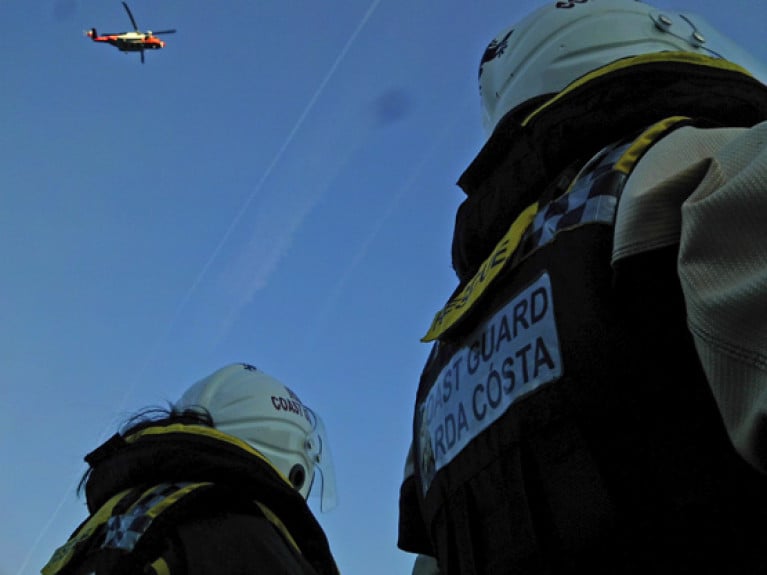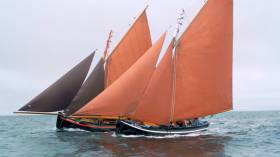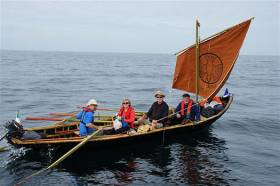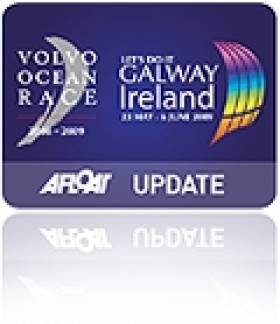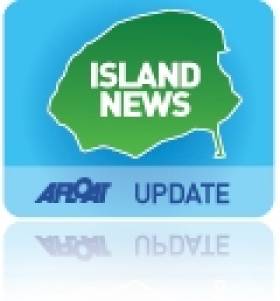Displaying items by tag: TG4
New TG4 Documentary Reaches Into Heart & Soul Of Irish Coast Guard
Following January’s film on Ireland’s offshore fishing industry, the latest episode of TG4 documentary series Tabú reaches into the heart and soul of the Irish Coast Guard — as told by the coastguard members in their own words.
In the aftermath of the loss of Rescue 116 and volunteer Caitríona Lucas, An Garda Cósta - Ár n-Insint Féin, which screens this coming Wednesday 4 March, explores how they continue to serve in spite of the tragedies.
Focusing on operations after the biggest tragedy that has happened to any Blue Light service in Ireland, the hour-long film reveals the anguish of the search, along with the coping mechanisms of “the coastguard family”.
And according to the producers, the documentary also reveals the dangers of the job and how they stay on the right side of risk.
Produced and directed by Darina Clancy for Midas Productions, Tabú: An Garda Cósta - Ár n-Insint Féin broadcasts Wednesday 4 March at 9.30pm on TG4.
Trawler Caught Fire And Sank During Filming For Documentary On Challenges Faced By Fishing Communities
The owner of a fishing trawler that took part in a new TG4 documentary series has revealed that the vessel caught fire and sinking during filming.
According to the Irish Examiner, the Susanne II was one of several vessels being followed by camera crews over a number of months for ‘Gafa sna Líonta’, the first episode in the new series of Tabú which starts next Wednesday 8 January at 9.30pm.
‘Gafa sna Líonta’ chronicles the stories of fishermen around Ireland’s coastal and the various challenges facing our coastal communities.
Cameras were not present at the time of the incident, however, in which the trawler’s three crew were airlifted to safety some 100km off the east coast.
Boat owner Ronan Forde explained how he feared for his men’s lives when he learned of their predicament at sea. The Irish Examiner has more on the story HERE.
#OnTV - A new four-part documentary series on the people of Ireland’s west who keep the Galway Hooker sailing tradition alive behind tomorrow night (Thursday 10 January) at 8pm on TG4.
Bádóirí provides an insight into seven Connemara families, part of one of the few indigenous communities of sailors left in Europe, as they compete to be champions of the Galway Hooker Association Racing League.
The first of four episodes screens tomorrow at 8pm and will be available to stream for viewers in Ireland on the TG4 Player.
Kerry Currach Voyaging On The Santiago Camino Features on TG4
The remarkable “voyages as pilgrimages” of a Kerry naomhog (currach) have been followed with fascination by an increasing number of maritime enthusiasts ever since the founding crew of Breandan Begley, Anne Bourke, Danny Sheehy and Liam Holden rowed, sailed and very occasionally outboard-motored the little vessel the whole way from southwest Ireland to the holy island of Iona in Scotland four year ago writes W M Nixon.
They brought with them the gift of a translation of the bible in Irish – a publication which apparently had been lacking in the Iona library.
For most sailors, that direct delivery would have been quite enough for one year. But in fact when the naomhog finally returned to Kerry, she’d completed a voyage round Ireland, having returned via the east and south coasts.
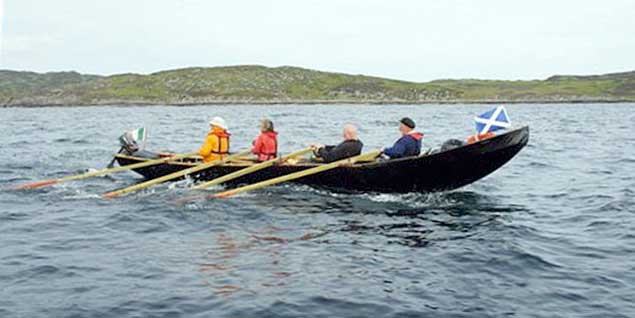 It wasn’t all easy sailing by any means. Much of the voyage to Iona and back round Ireland was achieved by muscle power. Photo Mark Tierney
It wasn’t all easy sailing by any means. Much of the voyage to Iona and back round Ireland was achieved by muscle power. Photo Mark Tierney
Once this was achieved, the idea of undertaking the ultimate European Atlantic seaboard pilgrimage voyage – from Ireland to Santiago Compostela in northwest Spain under sail and oar only – began to take shape, and last summer they completed it after two stages. They were accompanied by Paddy Barry’s 45ft cruiser Ar Seachran as mothership, though the little vessel made the long hops – with an overwinter in Brittany – entirely under her own steam.
In classic Camino style, it has been a picaresque venture, with some crew changes and new folk met at different times. Everyone involved has a strong association with Irish music, and by the time they got to Santiago their crew included Oscar-winning Dublin musician Glen Hansard, moving one of his shimates to comment that “having Glen Hansard rowing at sea was like bringing Shergar to plough a field”.
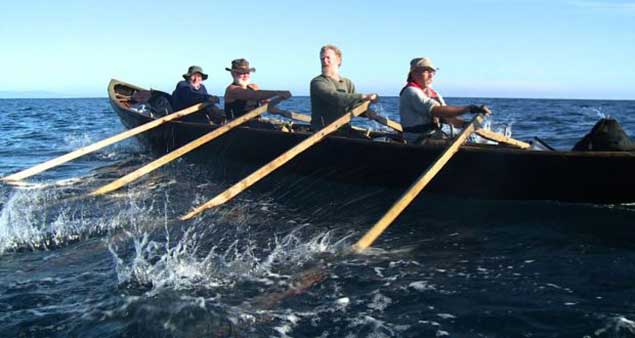 Getting your shoulders into it – Glen Hansard (second right) doing his bit off the coast of Spain
Getting your shoulders into it – Glen Hansard (second right) doing his bit off the coast of Spain
Happily for the rest of us, a three-part TG4 series has been made on the entire venture, and the first part airs this Sunday (February 19th) at 8.30pm, while for those who miss that particular bus, there’s a repeat on Monday February 20th at 7.30pm, with the same programming being continued for the next two weekends. Check out the weblink here
As for Paddy Barry, his extraordinary lifetime of combining cruising to remote regions with some very challenging mountaineering has been encapsulated in a live show, Sailing to Mountains & Other Cold Places, which he’ll be giving to the Irish Mountaineering Club at the Teachers’ Club, Parnell Square, Dublin 1 on Thursday, February 23rd February, and in the Maritime Museum in Dun Laoghaire on Thursday April 20th.
Meanwhile his own seafaring plans are undergoing change, as he has returned to his roots with the acquisition of a 27ft Galway Hooker gleotoig in Connemara, while his alloy-built Frers 45 Ar Seachran, a veteran of international Two Ton racing which he then very successfully used for high latitude voyaging, is now on the market.
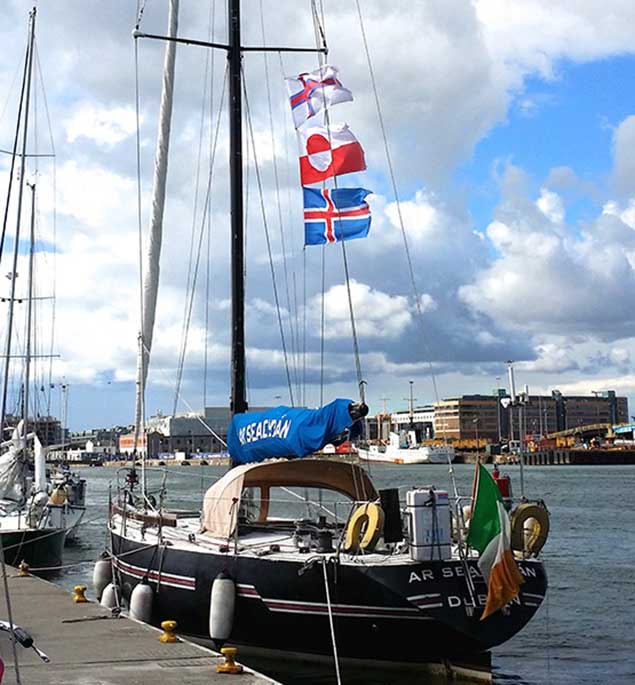 Paddy Barry’s Frers 45 Ar Seachran at Poolbeg in Dublin after returning from a voyage to Greenland. Photo Tony Brown
Paddy Barry’s Frers 45 Ar Seachran at Poolbeg in Dublin after returning from a voyage to Greenland. Photo Tony Brown
‘Nationwide’ Sets Sail for the Galway Volvo Ocean Race
#VOR ON NATIONWIDE – In addition to coverage of the Volvo Ocean Race on TG4 as previously reported, the prestigious global yachting event will also feature in tomorrow's edition of Nationwide on RTE 1 at 7 p.m.
Tens of thousands of visitors will travel to the City of the Tribes to welcome the Volvo Open 70 boats the formula one cars of the ocean and enjoy the festivities.
Nationwide meets the people responsible for bringing the event to Galway for the second time and how the people of Galway have come together to make this spectacular a reality. The programme will also take a closer look at the iconic Galway hooker boats.
#VOLVO OCEAN RACE - TG4 will broadcast tonight’s Volvo Ocean Race arrivals from Galway live at TG4.tv.
The boats are expected to arrive in Galway sometime between 2am and 4am tomorrow morning, and live commentary will be provided online by Martin Tasker and Peter Lester as the fleet approaches the finish line.
TG4's coverage begins this evening at 7.30pm with highlights from the start of Leg 9, following the fleet along the 485 natutical miles from Lorient to Galway through the treacherous waters of the Celtic Sea.
The channel will also present live coverage of the in-port race from Galway this Saturday 7 July from 12.45pm.
After nine months, nine legs and 39,000 nautical miles, it all comes down to this one race, the final scoring opportunity for teams in the 2011-2012 edition of the race which could well decide the overall podium positions.
The fleet will sail for an intense hour around a course positioned close to land to both challenge the crew and delight those lining the shore along Salthill and Barna.
Later this month, on Sunday 29 July at 2pm, TG4 will broadcast the official film for this edition of the Volvo Ocean Race.
The documentary will take a look back at the 2011/2012 race as the boats left Alicante last October, sailing around the world and visiting ports and cities such as Cape Town, Abu Dhabi, Sanya, Auckland, Itajaí, Miami, Lisbon, Lorient and Galway.
Delving into the world’s premier global race and one of the most demanding team sporting events in the world, the film will get close to the action in the ultimate mix of world class sporting competition and on-the-edge adventure, a unique blend of onshore glamour with offshore drama and endurance.
#VOR – Catch all the latest action and news from the Volvo Ocean Race on TG4 . TG4 will broadcast the in-port race live from Lorient next Saturday as well as the start of Leg 9 on Sunday. On Saturday 7th July, TG4 will broadcast the in-port Race from Galway. The race started in Alicante, Spain last October and finishes in Galway in July. The 2011-12 race is the 11th edition of the event with six boats participating: Groupama Sailing Team, Team Telefónica, PUMA Ocean Racing by BERG, CAMPER with Emirates Team NZ, Abu Dhabi Ocean Racing and Team Sanya.
*UPDATE: Please note change of timings to in-port race in Lorient on Saturday and start of Leg 9 on Sunday next*
Coverage on TG4
SATURDAY 30 JUNE
11:45am LIVE Volvo Ocean Race
Live coverage of the In-Port Race from Lorient, France. Situated in Brittany in north-west France, Lorient has a long-standing link to the maritime world and is the first French harbour to welcome the Race since La Rochelle did in 2002. The race course for the in-port race is always close to shore, so spectators will have a great view of the races.
SUNDAY 1 JULY
11:45am LIVE Volvo Ocean Race
Live coverage of the start of Leg 9, which sees the boats depart Lorient and make their way to Galway - a distance of 485 nautical miles (898 kilometres). Ironically, Lorient has been a twin town of Galway since 1978. The last stage of the Volvo Ocean Race will be short but intense with around 3 days at sea. The gun will be fired at 1pm in the Lorient's bay and the boat will head back south to Belle-Ile before they head back up towards Galway. The race's final sprint from France to Ireland takes the fleet on a predominantly coastal course: first north along the shores of western Brittany, then across the English Channel and up the prehistoric south coast of Ireland to the finish line in Galway. Short as it is compared to the preceding legs, this final passage is fraught with obstacles to be negotiated including commercial shipping lanes and rocky outcrops, as well as a seemingly endless series of headlands and major tidal gates. Added to this is the potential for rapidly changing weather conditions, which will keep the crews on their toes as they battle their way to the finish line in Galway.
MONDAY 2 JULY
7:30pm Volvo Ocean Race
Highlights from the start of Leg 9, which sees the boats depart Lorient and make their way to Galway, a distance of 485 nautical miles (898 kilometres).
SATURDAY 7 JULY
12:45pm LIVE Volvo Ocean Race
Live coverage of the in-port race from Galway Bay. After nine months, nine legs and 39,000 nautical miles it all comes down to this one race in Galway that will be broadcast live on TG4. The In-Port Race is the final scoring opportunity for teams in the 2011-2012 edition of the race so this is where the overall podium positions could be awarded. The fleet will sail for an intense hour around a course positioned close to land to both challenge the crew and delight those lining the shore along Salthill and Barna. The Galway stopover for the 2008-09 Volvo Ocean Race was a huge success for the city and for the race, and once again the Volvo Ocean Race will visit this ancient west coast city of Ireland, this time as the finish line of the 2011-12 race. The Volvo Ocean Race fleet will finish the race in the fabled waters of Galway Bay in July 2012 where they are bound to receive a tremendous Irish welcome at the end of the final leg from Lorient.
9:40pm Volvo Ocean Race
Highlights from the in-port race in Galway and the Prize Giving.
SUNDAY 29 JULY
2:00pm Volvo Ocean Race Official Film
A look back at the 2011/2012 race as the boats left Alicante last October, sailing around the world and visiting ports and cities such as Cape Town, Abu Dhabi, Sanya, Auckland, Itajaí, Miami, Lisbon, Lorient and Galway. It is undeniably the world's premier global race and one of the most demanding team sporting events in the world. The race is the ultimate mix of world class sporting competition and on the edge adventure, a unique blend of onshore glamour with offshore drama and endurance.
Wogan's Visit to Cape Clear Island
#ISLANDS - Cape Clear Island's most well-known couple may get even wider attention now that they're featured in Terry Wogan's new book on Ireland.
Micheál and Sile Ó Ceadagáin – who were the focus of TG4 programme Mí na Meala – are two of the many characters included in Wogan's Ireland, the book accompanying the legendary broadcaster's recent TV series.
According to the blog of the Cape Clear ferry service Cailín Óir: "The photographs [included] are stunning, including those of Cléire and Fastnet, to where Terry enjoyed an idyllic summer’s outing with Micheál on his boat The Gaisceannán.
"Micheál and Sheila are a hospitable couple which extends to the boat and Micheal's famous teas served at sea have pleased many, including the indefatigable Terry."
Wogan's Ireland is packed with photos and stories of Terry's whistle-stop tour of the country's 'coastal fringe', laced with his self-deprecating wit. The book is available online for as little as €10.
New Irish Language TV Series Unlocks Secrets of Ireland's Marine Environment
Ireland’s unexplored 220-million-acre marine environment will be revealed in a landmark new TV series which began last week.
As previously reported on Afloat.ie, Farraigí na hÉireann (Seas of Ireland) is a new six-part Irish-language series on Ireland's marine wildlife, which aired its first episode on TG4 last Tuesday 20 September.
Irish Film and Television News interviewed series co-creator Ken O'Sullivan about the unique series, which is the first of its kind in Ireland in unlocking the secrets of the abundant wildlife in the seas around our coast.
“We tried to combine coastal heritage with wildlife,” said O'Sullivan on the intentions behind the series. “We want to show how ancient coastal communities connected with wildlife.
"As filmmakers, our approach is that we try not to use science as the beginning and end of the story. We like to look at people’s connection with these natural worlds.”
As such, the series does not have a presenter, but its story is told through its contributors.
“We have passionate marine biologists and we have small fishermen, from places like the Aran Islands and Kerry, reflecting about their time at sea and how they relate to the sea, to try and convey the story.
"Hopefully, all these contributors bring a narrative to the unique underwater photography.”
And it's this underwater imagery that's surely the star of the show. As much as 70% of the series was filmed under the surface over the course of a year in locations around the country, using cameras in a special water-tight housing.
Deep water footage was also captured by high-definition cameras on an unmanned submarine, giving us the best ever view of life in the depths.
Farraigí na hÉireann can be seen Tuesdays at 8pm on TG4, with repeats on Sundays at 9pm.
Open Your Eyes to the Seas of Ireland
An exciting new six-part T.V. marine wildlife series 'Farraigí na hÉireann' (Seas of Ireland), the first to be dedicated entirely within our shores and also produced at home is to be broadcast by TG4 next Tuesday (20th Sept) at 8pm.
'Farraigí na hÉireann' explores the fascinating journey through the beautiful underwater world around Ireland encountering an enormous diversity of wild and colourful creatures. From playful dolphins, giant basking sharks and exotic jellyfish to the recently discovered cold water coral reefs in deep Atlantic waters.
It also examines the changing nature of our relationship with the sea and it's creatures from the original subsistence coast folk of 9,000 years ago and the traditions they have handed down, to the 'super-trawler' fishing fleet and the current state of our oceans.
To read more about the series visit www.seafeverproductions.com and www.tg4.ie


























